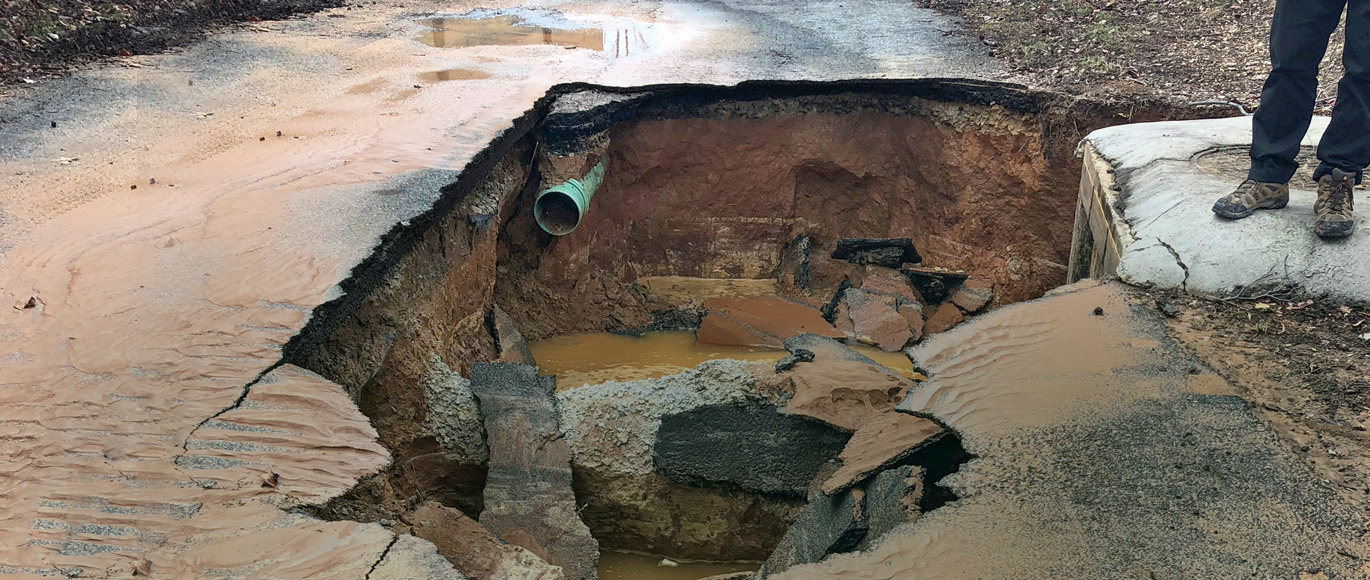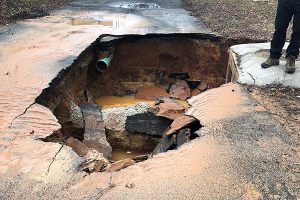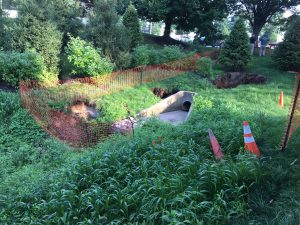
Pennoni’s Geotechnical division has extensive experience evaluating and remediating sinkholes that typically form within the solution-prone limestone/dolomite geology found throughout the  Valley and Ridge Physiographic Province. This province extends through most of the Pennoni service areas, particularly, within the Greater Philadelphia and Lehigh Valley regions. Due to the unusually large amount of precipitation recently, there has been a higher occurrence of sinkhole activity throughout the region. Sinkholes often happen when precipitation or other water sources cause soil to erode into preexisting solution channels with the bedrock. Significant damage to buildings, roads, bridges, and underground utilities can occur due to sinkhole related subsidence. Our team of geotechnical engineers and geologists evaluate sinkholes and recommend stabilization solutions.
Valley and Ridge Physiographic Province. This province extends through most of the Pennoni service areas, particularly, within the Greater Philadelphia and Lehigh Valley regions. Due to the unusually large amount of precipitation recently, there has been a higher occurrence of sinkhole activity throughout the region. Sinkholes often happen when precipitation or other water sources cause soil to erode into preexisting solution channels with the bedrock. Significant damage to buildings, roads, bridges, and underground utilities can occur due to sinkhole related subsidence. Our team of geotechnical engineers and geologists evaluate sinkholes and recommend stabilization solutions.
Our team approaches sinkhole repair with a strong understanding of key factors that trigger sinkhole development and use a variety of exploration tools. Explorations generally consist of a review of the available subsurface data, use of geophysics, and excavation or drilling (SPT drilling or percussion). The objective of exploration is to define the current subsurface conditions and the extent of the sinkhole. Remediation generally includes the use of stone and geosynthetic fabric, impermeable grout mix, and or the development and direction of compaction grouting as appropriate for and specific to the conditions disclosed during the exploration. A successful remediation requires arresting subsoil erosion by constructing an impermeable barrier and protecting the area from future exposure to water.
As recent as February of this year, a client of ours reached out to help remediate an enormous sinkhole caused by a water main break. Our geotechnical  team provided and directed a series of stabilization strategies that included excavation and replacement of loose, wet soils, and compaction grouting to stabilize the subsoils. Overall, the area remediated was 20,000 SF.
team provided and directed a series of stabilization strategies that included excavation and replacement of loose, wet soils, and compaction grouting to stabilize the subsoils. Overall, the area remediated was 20,000 SF.
In addition to the active sinkhole stabilization services, we routinely conduct carbonate geology studies and provide pre and post site development surveys using geophysics. Some of the geophysical methods used include ground penetrating radar (GPR), electrical resistivity (ER), terrain conductivity (EM), seismic refraction/MASW, and microgravity. Our team evaluates the data for predevelopment stormwater management feature placement or postdevelopment solutions to repair the damaged areas which often include replacing soil that has been washed out. We also provide oversight in the construction of the repairs.
If you have sinkhole concerns or require sinkhole stabilization services contact Rick Brinker, PE for assistance.
Rick serves as Associate Vice President and Division Manager for Pennoni. He has nearly 35 years of experience in civil engineering with specialized expertise in geotechnical and geo-environmental engineering. He is responsible for division staff management, business development, proposal preparation and reviews, technical direction and review of geotechnical reports/engineering calculations, contract reviews, financial performance, and technical mentoring/guidance of division personnel.
Contact Rick for more information.
